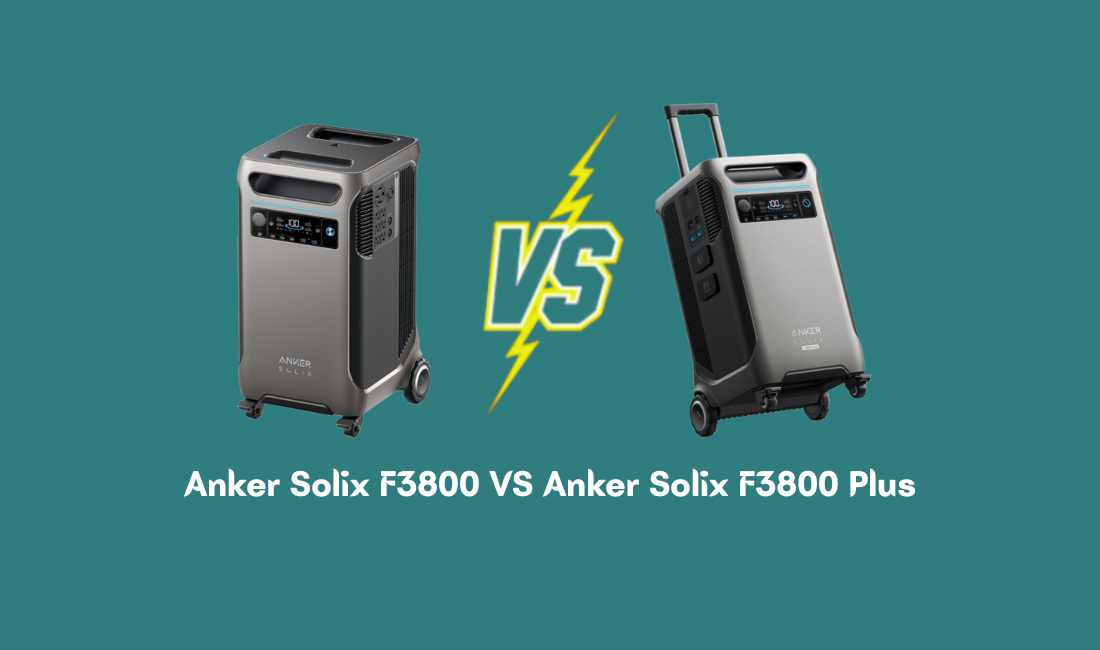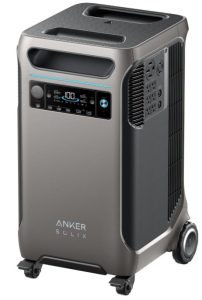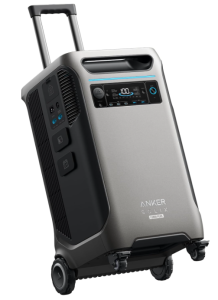
Anker Solix F3800 vs F3800 Plus: Which One Powers Your World Better?

Anker’s Solix series has redefined how people think about portable and home backup power. The F3800 and F3800 Plus stand as two of the most advanced power stations on the market, each engineered to deliver clean, reliable energy for homes, RVs, and off-grid adventures.
The F3800 packs strong capacity, dual solar input, and a design built for durability and performance. The F3800 Plus raises the bar with faster charging, expanded energy management, and seamless scalability for larger setups.
Both models share Anker’s signature efficiency and smart controls, but their differences reveal two distinct approaches to energy freedom. Choosing between them depends on how much power, flexibility, and control your lifestyle demands.
Exploring this comparison uncovers which Solix model truly leads the charge in reliable, future-ready energy solutions for both everyday use and long-term independence.
Anker SOLIX F3800 vs F3800 Plus: Full Consumer Review and Comparison
Portable power stations have become more than just camping tools. They are now part of modern homes, RVs, and even small businesses. Anker, a trusted name in the tech world, has taken a big step into this space with its SOLIX series.
Two of its most talked-about models — the Anker SOLIX F3800 and Anker SOLIX F3800 Plus — stand out for their raw strength and long-lasting battery performance.
This detailed comparison helps you understand how these two giants differ, what makes each special, and which one fits your lifestyle better.
The review is written in plain language so anyone can easily follow along. Let’s start with the first model — the Anker SOLIX F3800.
Anker SOLIX F3800
Product Details
The Anker SOLIX F3800 is built for those who need serious power support. It carries a 3.84kWh LiFePO4 battery, capable of running multiple appliances at once. With a 6,000W AC output and 120V/240V dual voltage, it can power anything from refrigerators and washing machines to electric vehicles.
This model weighs 132.3 pounds, which shows it’s not a small backup battery — it’s a full-scale portable generator without the noise or gas smell. It’s ideal for homes, RVs, and outdoor power setups.
The build quality feels premium. The body is reinforced to handle travel bumps and outdoor conditions. Anker uses InfiniPower technology, which combines long-life LFP batteries, smart cooling systems, and industrial-grade components. That means the F3800 is built to last over 10 years, even with daily use.
Anker also includes everything you need in the box — the portable power station, AC charging cable, solar charging connectors, and a user manual.
Features
-
3.84kWh base capacity expandable up to 26.9kWh with extra battery packs.
-
6,000W dual-voltage AC output (120V/240V) for all heavy home appliances.
-
EV-ready port (NEMA 14-50) for direct electric vehicle charging.
-
RV-friendly design with NEMA 14-50 and L14-30 ports.
-
Wi-Fi and Bluetooth app control to manage energy use in real time.
-
Smart temperature regulation for safe performance during long use.
-
LiFePO4 battery technology ensures safe, long-lasting power.
-
Impact-resistant shell for durability in outdoor conditions.
-
5-year warranty with Anker’s customer support.
What Is the Good?
The Anker SOLIX F3800 delivers strength and flexibility. It powers almost everything in a household, from basic gadgets to energy-hungry appliances. The dual-voltage output makes it more capable than standard power stations.
The InfiniPower battery system is a major highlight. It means users don’t need to worry about the battery losing health too soon. The app control also feels convenient — being able to check usage and remaining charge from your phone is a big plus.
Another strong point is expandability. You can start with the main unit and add battery packs later, which saves money in the long run.
What Is the Bad?
The F3800’s main downside is weight. At over 130 pounds, it’s not easy to move around. It also has limited solar input capacity compared to the newer F3800 Plus.
The price may feel high for users who only need backup for small devices. Some users also wish for faster solar charging options.
Overall Opinion
The Anker SOLIX F3800 is made for people who take backup power seriously. It works perfectly for home emergencies, RVs, and off-grid cabins. The build is rock-solid, and the power delivery is stable.
For users who value reliability and durability, this model remains one of the most trusted choices in the large-capacity power station segment.
Anker SOLIX F3800 Plus
Product Details
The Anker SOLIX F3800 Plus takes the strengths of the F3800 and upgrades almost every part of it. It has the same 3.84kWh capacity, but it now supports a 3,200W solar input, making it far more efficient for solar users.
This version is slightly heavier at 135.6 pounds, showing a more solid internal structure. It can connect directly to solar panels or gas generators, which gives it unmatched flexibility during long power outages.
It’s not just about bigger numbers — the Plus version improves real-world performance. It can be expanded up to 53kWh, which is twice the expansion limit of the base F3800. For users who rely fully on renewable energy, this makes a huge difference.
The design remains sleek and modern, with a focus on user-friendly controls. The front panel layout is clean, and all ports are clearly labeled. Anker also includes solar cables, AC cables, user manual, and warranty card.
Features
-
3.84kWh capacity, expandable up to 53kWh with battery packs.
-
6,000W AC output with 120V/240V dual-voltage support.
-
3,200W solar input for faster charging during the day.
-
Generator input support through 6,000W bypass mode.
-
Compatible with EVs and RVs via NEMA L14-30 and TT-30P ports.
-
Smart app control for Wi-Fi and Bluetooth.
-
InfiniPower technology for 10+ years of reliable service.
-
5-year warranty and strong Anker customer service.
-
Built for solar-first users, ideal for energy savings and long-term use.
What Is the Good?
The F3800 Plus stands out with its charging flexibility. The high solar input lets users recharge faster, even in cloudy weather. It also works with gas generators, giving more options during emergencies.
The 53kWh expansion limit is another major step forward. It makes the Plus version perfect for large homes or users planning long-term off-grid living.
The improved port design also makes connection easier, especially for EVs and RV setups. Its app interface feels smooth, showing power levels, charging speed, and temperature details clearly.
What Is the Bad?
The F3800 Plus costs more than the standard version. The extra solar input and expansion ability raise the price tag. It’s also heavy, so most users will prefer keeping it in a fixed place.
The app setup can feel confusing for beginners during the first few uses, though once configured, it works smoothly.
Overall Opinion
The Anker SOLIX F3800 Plus is for those who want the best of everything. It’s not just a backup battery — it’s a full power system. It can run homes, charge EVs, and support camping or business needs.
The new solar input support and dual power options (solar + generator) make it one of the most complete models in the high-end market. It suits users who want complete independence from the grid.
Detailed Comparison: Anker SOLIX F3800 vs F3800 Plus
At first glance, both models seem similar. They share the same base 3.84kWh capacity, 6,000W dual-voltage AC output, and 10-year lifespan. But the difference becomes clear once you dig into solar power, expandability, and convenience.
The F3800 Plus wins in solar input — it supports 3,200W, while the standard F3800 has much lower solar charging speed. This allows the Plus to recharge almost twice as fast, making it far better for solar-first homes or RVs.
Expansion is another key difference. The regular F3800 reaches up to 26.9kWh, while the Plus doubles that to 53kWh. This extra capacity makes it perfect for longer power cuts or off-grid setups.
The F3800 remains more affordable, though. For users who need a dependable home backup system but don’t care much about fast solar charging, it offers better value.
Another difference is generator compatibility. The F3800 Plus supports gas generator bypass, allowing users to keep charging the system during cloudy days. This makes it more flexible for remote or emergency use.
In terms of design and usability, both models are solid. The Plus version feels slightly more refined, with smoother handle placement and cleaner interface layout. Both offer Anker app control, LFP battery technology, and smart cooling systems.
If you travel with an RV, the Plus is easier to integrate due to its dedicated ports. If you just want a reliable power station for your home or cabin, the F3800 does the job well.
Overall, both share the same DNA — durable, safe, and efficient. The difference lies in power flexibility and charging speed.
USES
In real-world tests, both stations perform impressively. The F3800 can keep a refrigerator, router, and a few lights running for almost one full day on a single charge. The F3800 Plus, with its faster solar charging, easily keeps power flowing continuously when paired with two 400W solar panels.
Both units are quiet during operation. The fans turn on only during heavy loads, and the noise is far less than any gas-powered generator. The smart app helps track every watt used, which is useful for energy planning.
RV users will find the Plus version slightly better since it supports direct connection to RV power inlets. The F3800, on the other hand, fits better for fixed home use or emergency setups.
FAQs
1. What’s the main difference between Anker SOLIX F3800 and F3800 Plus?
The Plus version has higher solar input (3,200W), generator compatibility, and double the expansion capacity (53kWh).
2. Can I use both with solar panels?
Yes. Both models support solar charging. The Plus recharges much faster due to its higher input capacity.
3. How long can they power a home?
It depends on the load. The 3.84kWh base capacity can run lights, routers, and small appliances for 10–15 hours. With expansion, they can last for several days.
4. Are they safe for indoor use?
Yes. They don’t emit fumes like gas generators and are designed for safe indoor operation.
5. Can both charge electric vehicles?
Yes. Both include EV charging ports, but the Plus version supports broader EV compatibility.
6. Which one should I choose for camping?
For short camping trips, the F3800 is enough. For long off-grid stays, the F3800 Plus offers more flexibility.
7. Do they work during power outages automatically?
They can be manually switched on. With a transfer switch, they can automatically power essential circuits.
8. How long do the batteries last?
Both models use LiFePO4 cells rated for over 3,000 cycles, equal to more than 10 years of use.
Conclusion
Both the Anker SOLIX F3800 and Anker SOLIX F3800 Plus stand out as strong, durable, and reliable portable power stations. The F3800 offers dependable home backup at a lower cost.
It’s great for users who need strong output and solid build quality without the need for extreme expansion. The F3800 Plus takes that same foundation and makes it future-proof.
Faster solar charging, generator input, and 53kWh expansion give it an edge for long outages, off-grid homes, and energy independence. Both models share the same Anker reliability, smart app features, and 10-year lifespan.
If you need a steady home backup, choose the F3800. If you want a full solar-ready system that can grow with your needs, the F3800 Plus is the smarter choice.
Both prove that Anker’s SOLIX line isn’t just another power station — it’s dependable, intelligent power for modern life.


